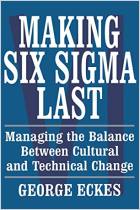
Read or listen offline
Amazon KindleRecommendation
This book is one of the few thorough, detailed, systematic guides to team leadership in the context of Six Sigma. Those assigned to lead or participate in Six Sigma teams will find it hands-on practical and consistently useful. To use this specific approach to team management, you need to be familiar with the Six Sigma concept and process already. Then, this straightforward, explanatory manual will take you step by step, list by list, through the task of facilitating a successful team, from establishing a plan to dealing with problem personalities. It isn’t exactly juicy reading, except for the lively illustrative anecdotes, and the grammar is occasionally awkward given the jargon involved, but this focused package of instructions will help you get the job done effectively and efficiently. getAbstract.com recommends it enthusiastically to managers who are embarking upon, or already involved in, a Six Sigma team management process.
Summary
About the Author
George Eckes is founder, president and CEO of Colorado-based Eckes & Associates, Inc., whose client list includes JPMorgan Chase, Wells Fargo, Cisco and General Electric. He wrote The Six Sigma Revolution and Making Six Sigma Last.

























Comment on this summary or Démarrer une discussion